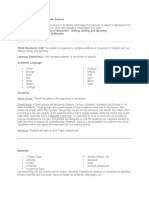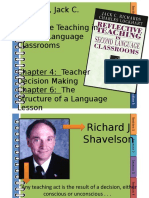Sink or Float
Sink or Float
Uploaded by
api-130459391Copyright:
Available Formats
Sink or Float
Sink or Float
Uploaded by
api-130459391Original Title
Copyright
Available Formats
Share this document
Did you find this document useful?
Is this content inappropriate?
Copyright:
Available Formats
Sink or Float
Sink or Float
Uploaded by
api-130459391Copyright:
Available Formats
LESSON PLAN Bearspaw School, Grades 4, 5, 6 Title: To Float or Sink That is the Question Date: January 29, 2013
3 Session: 1
Essential Question: Why do the various objects sink or float when placed in water? Throughout this lesson students will investigate the nature of things, demonstrating purposeful action that leads to inferences supported by observations (Science POS - GLE 4-1). Time Instructor Activities Learner Activities Learners will engage in the KWL chart using their background knowledge to demonstrate their current understanding of the topic of floating and sinking. Learners will have the opportunity to demonstrate their ideas and understanding of the lesson through their predictions of what they think will happen. Engage in the activity and discuss with their peers while documenting their discoveries. Discuss their findings and supporting rational to the questions both provided and asked of them by the instructors. Resources KWL charts (15 copies) Scientific observation sheets (15)
5 min Lead and explain KWL chart approx.
Lead students through predictions 5 min approx. 15 min Observing and assessing students as they approx. complete the experiment. Instructors will ask thought-provoking questions. Instructors will complete the lesson by explaining the method of self-evaluation, further allowing the instructors to assess each learners comprehension of the lesson.
Bowl, H2O, Ping Pong Ball, Rock, Students will then complete the self-evaluation to fairly reflect on their Paperclip, ideas and understanding of the lesson. Popsicle Stick, Cotton Ball, Ball of Clay, Sponge, Leaf, Tinfoil. Comments: Instructors will work to ensure each student is fully engaged in the task at hand. Instructors will encourage students to challenge themselves, developing a higher-level of thinking for this lesson. This will be accomplished through consistent questioning to continue a more in depth level of observation. Special Accommodations: May need to provide more detailed instructions, demonstrate and model for students who need extra support. Individuals may have a teacher scribe for the worksheet if needed. Encouragement and support will be given to write as much as they can on their own. Teachers will check in periodically with these students to monitor understanding and engagement in the activity. Assessment: Both observations and formative assessment will be the primary source used to assess the students throughout this activity. Students worksheets will be collected at the end of the lesson and will be used to help assess the students understanding. Students will also engage in selfassessment at the end of the lesson, not only to reflect on their own learning, but also as a means of demonstrating their comprehension of the lesson.
ISW Handbook for Participants Revised from Provincial Instructor Diploma Program Course 102A
What worked well/what needs revision:
ISW Handbook for Participants Revised from Provincial Instructor Diploma Program Course 102A
You might also like
- Four Principles of Interpersonal Communication50% (2)Four Principles of Interpersonal Communication4 pages
- Unit 2 Lesson Plan: 4164 Cambridge International Certificate in Teaching and Learning83% (6)Unit 2 Lesson Plan: 4164 Cambridge International Certificate in Teaching and Learning2 pages
- B Instructional Scarffolding and Task AnalysisNo ratings yetB Instructional Scarffolding and Task Analysis7 pages
- Lesson 1 Unit Overview: Ms. Rebecca Wambui Action ABC's: VERBS 30 Minutes Grade 1No ratings yetLesson 1 Unit Overview: Ms. Rebecca Wambui Action ABC's: VERBS 30 Minutes Grade 13 pages
- Pre & Primary Teacher Training Phase - 3: Lesson Planning and Instructional Strategies What Is A Lesson Plan?No ratings yetPre & Primary Teacher Training Phase - 3: Lesson Planning and Instructional Strategies What Is A Lesson Plan?73 pages
- English Grade 1 Teaching Guide First Term85 PDFNo ratings yetEnglish Grade 1 Teaching Guide First Term85 PDF175 pages
- Spectrum English Grade 2 Teaching Guide First Term77No ratings yetSpectrum English Grade 2 Teaching Guide First Term77249 pages
- Post Graduate Diploma in Pre & Primary Teacher Training Phase - 3100% (1)Post Graduate Diploma in Pre & Primary Teacher Training Phase - 378 pages
- Sunderland K s267966 Etp410 Assignment 1No ratings yetSunderland K s267966 Etp410 Assignment 15 pages
- Greeting (1 Min) : Hello, Boys and Girls! How Are You?No ratings yetGreeting (1 Min) : Hello, Boys and Girls! How Are You?3 pages
- Short Lesson Plan Template Science Sink or Float Grade 1No ratings yetShort Lesson Plan Template Science Sink or Float Grade 15 pages
- Pompeii - . - Buried Alive, Transparency Showing Different Parts of A VolcanoNo ratings yetPompeii - . - Buried Alive, Transparency Showing Different Parts of A Volcano5 pages
- Richards, Jack C. Reflective Teaching in Second Language ClassroomsNo ratings yetRichards, Jack C. Reflective Teaching in Second Language Classrooms35 pages
- Name: Nicole Liu - Grade Level Being Taught: 1st Subject/Content: Science/Conclusion Group Size: Whole Date of Lesson: 11/9/16No ratings yetName: Nicole Liu - Grade Level Being Taught: 1st Subject/Content: Science/Conclusion Group Size: Whole Date of Lesson: 11/9/168 pages
- Spectrum English Grade 2 Teaching Guide Second Term800% (1)Spectrum English Grade 2 Teaching Guide Second Term80269 pages
- STEPP Lesson Plan Form: Colorado State University College of Health and Human Sciences Page 1No ratings yetSTEPP Lesson Plan Form: Colorado State University College of Health and Human Sciences Page 15 pages
- Teaching Approach and Strategies in ScienceNo ratings yetTeaching Approach and Strategies in Science24 pages
- Daily Lesson Plan: VDOE English 10 ObjectivesNo ratings yetDaily Lesson Plan: VDOE English 10 Objectives2 pages
- Developmental Milestones Checklist BS Psy 2DNo ratings yetDevelopmental Milestones Checklist BS Psy 2D18 pages
- 205-4 Child Development: A Psychological Analysis On The Cognitive Development of Human Persons.No ratings yet205-4 Child Development: A Psychological Analysis On The Cognitive Development of Human Persons.39 pages
- Shift of Educational Focus From Content To Learning OutcomesNo ratings yetShift of Educational Focus From Content To Learning Outcomes18 pages
- Comparison of Piaget and Vygotsky: Cognitive and Language DevelopmentNo ratings yetComparison of Piaget and Vygotsky: Cognitive and Language Development16 pages
- Development and Examination of The Linguistic Category Model in A Computerized Text Analysis MethodNo ratings yetDevelopment and Examination of The Linguistic Category Model in A Computerized Text Analysis Method13 pages
- MODULE 2-Entrep Characteristics of Entrepreneurs and ROLES OF ENTREPRENEURSHIP TO ECONOMIC DEVELOPMENT AND SOCIETYNo ratings yetMODULE 2-Entrep Characteristics of Entrepreneurs and ROLES OF ENTREPRENEURSHIP TO ECONOMIC DEVELOPMENT AND SOCIETY4 pages
- What Are The Effects of Cellphones On StudentsNo ratings yetWhat Are The Effects of Cellphones On Students2 pages
- Society For Developmental and Behavioral.3No ratings yetSociety For Developmental and Behavioral.323 pages
- DISC Personality Test Result - Free DISC Types Test Online at 123testNo ratings yetDISC Personality Test Result - Free DISC Types Test Online at 123test6 pages
- Psychology SL Biological Approach Studies and DefinitionsNo ratings yetPsychology SL Biological Approach Studies and Definitions9 pages
- Good Dissertation Topics For Sports Therapy100% (2)Good Dissertation Topics For Sports Therapy5 pages
- Perspectives On Spirituality at The End PDFNo ratings yetPerspectives On Spirituality at The End PDF11 pages

























































































